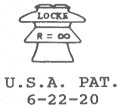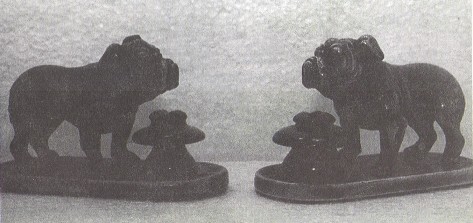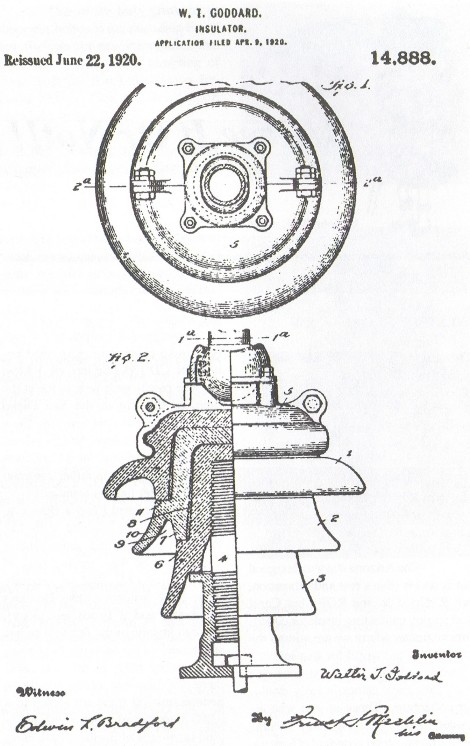Porcelain Insulator News
by Elton Gish, NIA #41
Reprinted from "Crown Jewels of the Wire", August 1991, page 7
Various people have reported similar markings on multipart porcelain
insulators that we still have not been able to confirm with 100% certainty. The
marking is always weak in one area or another making it impossible to
determine the date. However, with several reports I believe that I can now make
a good guess.

The most complete marking was reported by Mike Jordan (shown above). It was on a three-part insulator with "U.S.A. PAT. "
underneath and a date under that. To avoid confusion, I have shown what I
believe to be the correct date. Mike's marking was the clearest, however, he
said that he was not sure of the date. It looked like "2-20- 20". This
date is not a Tuesday. Since patents are only granted on Tuesdays, the date is obviously wrong. The insulator is
M-2611 with a reddish-brown glaze
characteristic of Locke manufacture (photo below).

Mike
Guthrie reported a similar marking on M-2614 with what he guessed was the date
"6-23-10". That, too, is not a Tuesday. Robin Harrison reported
"A.PAT" markings on M-2614C and M-3541 each with the Locke R=oo
insulator logo.
The M-2614C had marking "A. PAT. /1-2?" under the
insulator logo and the M-3541 had the marking "A. PAT. /??-20". Chris
Hedges reported the marking "PAT / 4-22-2?". So, you can see that we
have little to go on with exception of Mike Jordan's nearly complete marking, and
at first glance you might think that none of these markings are related.
We can
assume that the patent in the marking was a patent assigned to Locke patent
since the insulator logo marking was Locke's and the specimens appeared to be of
Locke manufacture. Next check the similarities of the reported dates keeping in
mind that with weak markings, reported numbers could easily be in error from the
actual date:
|
2-20-22
|
6-23-10
|
4-22-2?
|
1-2?
|
??-20
|
Even with all of the poor incuse date markings, it is obvious that the first
digit of the day is a "2" and that year is probably in the 1920's. I
checked all of the Locke patents for the 1920's with a Tuesday on the
"2?". Reissue patent #14,888 seems to fit with a patent date of
6-22-20. A copy of the patent drawing is shown at the end of this article or you
can turn to page 113 in my book Multipart Porcelain Insulators . This is a reissue
of patent #1,311,067 granted to Walter T. Goddard for a multipart insulator
design which was similar to the Faradoid patent #1,374,998 assigned to
Westinghouse (see my book on page 114). [Note: if there is a minor error in the
published patent, a reissue patent number may be assigned by the patent office
to correct the error.]
If you study the reported patent dates, you can see that
they are indeed variations of the true patent date given the legibility of the
weak markings! So, I am 90% sure that we have solved this mysterious marking. As
a hint, if you have a porcelain insulator with an incuse marking that is
difficult to read, take the insulator outside in bright sunlight. This will make
the weak marking more easily read.
Wayne Elworth sent me several photographs of an advertising promotional
paperweight that I have not seen before now. It is made of porcelain in the form
of a three-part insulator similar to M-3440 and with "LOCKE" in large letters embossed on the top skirt. It is about
3" tall with chocolate brown glaze (see the two photos above). I would
guess that it was made circa 1927-1930's.
There are many variations of insulator
company giveaways. These are typically called "salesmen's samples".
Most would serve a useful function such as ash trays or coffee mugs so they
would always be visible on someone's desk. Locke made many thousands of coffee
mugs over the years, but they were permanently discontinued last year. I have a
bronze bulldog standing over a multipart insulator sitting on my desk at home.
It was made for the Illinois Electric Porcelain Co. The tradename for their line
of nail knobs was "BULLDOG".

I recently was going through, a 1928 Lapp catalog. I found references to
three patents that I did not have in my patent file of more than 1045 insulator
related patents. By the way, I have copies of all 1045+ insulator patents. I
will send you a copy of any of these patents for $1.00 postpaid and unfolded.

I also found some interesting information about Lapp glazes and markings. First,
the Lapp underglaze ink marking which includes the date (see example above)
is not used on every insulator. Small insulators are thus marked about every
fifth piece; larger pin type insulators and all suspension types are each
marked. The purpose for marking was, "You thus have the year of production,
which in nearly every case will also be the year of erection imperishable
recorded in your stock, and on your line to give a basis for service
record."
There were a variety of glazes offered:
|
Standard
|
Brown (the brown may be described as "mahogany" or red-brown) [this
is the standard pumpkin color]
|
|
Blue
|
the blue is a rich, deep color
|
Lt. Blue
|
dark sky blue
|
|
White
|
|
|
Chocolate
|
a rich, glossy glaze of the color of dark chocolate coating.
|
lam not familiar with availability of Lapp insulators in various glaze
colors. Several unipart types with pretty light blue glaze have been reported.
This may be their "light blue" rather than the "blue". I am
not sure if I have ever seen a white Lapp. Even chocolate seems to be uncommon
compared to the uniform pumpkin Lapps. It is not surprising that Lapp persisted
for many years with the pumpkin glaze as it was pretty and easily displayed
their famous underglaze ink markings.

Large Image (212 Kb)
| 